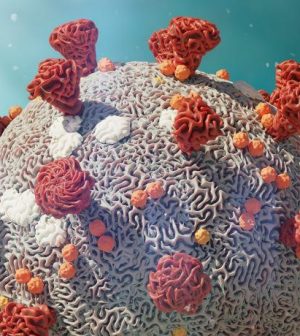- Navigating Your Midlife Crisis: Embracing New Possibilities
- City Raccoons Showing Signs of Domestication
- Mapping the Exposome: Science Broadens Focus to Environmental Disease Triggers
- One Week Less on Social Media Linked to Better Mental Health
- Your Brain Changes in Stages as You Age, Study Finds
- Some Suicide Victims Show No Typical Warning Signs, Study Finds
- ByHeart Formula Faces Lawsuits After Babies Sickened With Botulism
- Switch to Vegan Diet Could Cut Your Greenhouse Gas Emissions in Half
- Regular Bedtime Does Wonders for Blood Pressure
- Dining Alone Could Mean Worse Nutrition for Seniors
COVID Virus Lingers in Tissues for Over a Year

The COVID-19 virus can linger in the blood and tissue of patients for more than a year after they’ve shaken their initial infection, new findings show.
Researchers found pieces of SARS-CoV-2, the virus behind COVID, lingering in the blood for up to 14 months and in tissue samples for more than two years post-infection.
It’s possible that these viral fragments contribute to Long COVID symptoms experienced by as many as three in 10 people infected with COVID, researchers said.
“These two studies provide some of the strongest evidence so far that COVID antigens [immune system markers] can persist in some people, even though we think they have normal immune responses,” said Dr. Michael Peluso, an infectious disease researcher in the University of California, San Francisco School of Medicine.
Early in the pandemic, COVID was thought to be a short-term illness like the flu.
However, a growing number of patients have experienced Long COVID, a syndrome that causes a variety of health issues for months or even years, researchers noted. Symptoms can include brain fog, digestive problems, ongoing breathing difficulty and heart palpitations.
For this study, researchers first analyzed blood samples from 171 people infected with COVID.
Their ultra-sensitive test specifically looked for the COVID “spike” protein, which helps the virus break into human cells.
The likelihood of detecting leftover viral particles was about twice as high in people hospitalized for a severe case of COVID, researchers found. It also was higher for people who reported being sicker but were not hospitalized.
“As a clinician, these associations convince me that we are on to something, because it makes sense that someone who had been sicker with COVID would have more antigen that can stick around,” Peluso said.
The researchers then turned to the UCSF Long COVID Tissue Bank, which contains samples donated by patients who’ve tussled with the infectious disease.
They detected pieces of viral genetic material for up to two years after infection, even though there was no evidence the patient had become reinfected.
They found this leftover COVID virus in connective tissue where immune cells are located, suggesting that the viral fragments were causing the immune system to attack.
And in some samples, the researchers found the virus could be active.
More research is needed to determine whether these lingering particles contribute to Long COVID, Peluso said.
Based on these findings, it could be that monoclonal antibodies or antiviral drugs might be able to help people with Long COVID by flushing the remaining virus from their bodies, Peluso said. His team is pursuing multiple clinical trials to test this possibility.
“There is a lot more work to be done, but I feel like we are making progress in really understanding the long-term consequences of this infection,” Peluso said.
These findings were presented at the Conference on Retroviruses and Opportunistic Infections, which took place last week in Denver. Findings presented at medical meetings should be considered preliminary until printed in a peer-reviewed journal.
More information
The U.S. Centers for Disease Control and Prevention has more about Long COVID.
SOURCE: University of California, San Francisco, news release, March 7, 2024
Source: HealthDay
Copyright © 2025 HealthDay. All rights reserved.










